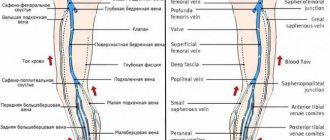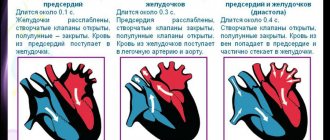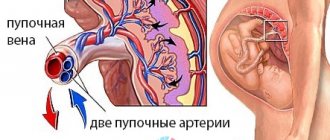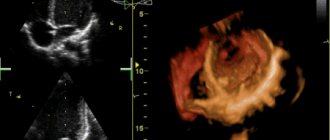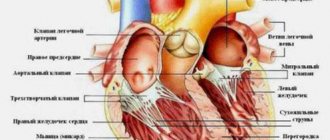Human circulatory system: structure and functions
Normal life activity is impossible without effective blood circulation: it maintains the constancy of the internal environment, transports oxygen, hormones, nutrients and other vital substances, takes part in the cleansing of toxins, waste, decay products, the accumulation of which would sooner or later lead to the death of an individual organ or the whole organism. This process is regulated by the circulatory system - a group of organs, thanks to the joint work of which blood is consistently moved throughout the human body.
Let's look at how the circulatory system
, and what functions it performs in the human body.
The structure of the human circulatory system
At first glance, the circulatory system is structured simply and clearly: it includes the heart and numerous vessels through which blood flows, successively reaching all organs and systems. The heart is a kind of pump that stimulates the blood, ensuring its smooth flow, and the vessels play the role of guiding tubes that determine the specific path of blood movement throughout the body. That is why the circulatory system is also called the cardiovascular or cardiovascular system.
Let's talk in more detail about each organ that belongs to the human circulatory system.
Organs of the human circulatory system
Like any organismal complex, the circulatory system includes a number of different organs, which are classified depending on their structure, location and functions:
- The heart is considered the central organ of the cardiovascular complex. It is a hollow organ formed primarily by muscle tissue. The cardiac cavity is divided by partitions and valves into 4 sections - 2 ventricles and atria (left and right). Thanks to rhythmic successive contractions, the heart pushes blood through the vessels, ensuring its uniform and continuous circulation.
- Arteries carry blood from the heart to other internal organs. The further from the heart they are located, the thinner their diameter: if in the area of the heart sac the average width of the lumen is the thickness of a thumb, then in the area of the upper and lower extremities its diameter is approximately equal to a simple pencil.
Despite the visual difference, both large and small arteries have a similar structure. They include three layers - adventitia, media and intima. The adventitium, the outer layer, is formed by loose fibrous and elastic connective tissue and includes many pores through which microscopic capillaries pass, feeding the vascular wall, and nerve fibers that regulate the width of the lumen of the artery depending on the impulses sent by the body.
The media, which occupies the median position, includes elastic fibers and smooth muscles, thanks to which the firmness and elasticity of the vascular wall is maintained. It is this layer that largely regulates the speed of blood flow and blood pressure, which can vary within an acceptable range depending on external and internal factors affecting the body. The larger the diameter of the artery, the higher the percentage of elastic fibers in the middle layer. According to this principle, vessels are classified into elastic and muscular.
The intima, or inner lining of the arteries, is represented by a thin layer of endothelium. The smooth structure of this tissue facilitates blood circulation and serves as a passageway for media nutrition.
As the arteries thin, these three layers become less pronounced. If in large vessels the adventitia, media and intima are clearly distinguishable, then in thin arterioles only muscle spirals, elastic fibers and a thin endothelial lining are noticeable.
- Capillaries are the thinnest vessels of the cardiovascular system, which are an intermediate link between arteries and veins. They are localized in the areas most distant from the heart and contain no more than 5% of the total blood volume in the body. Despite their small size, capillaries are extremely important: they envelop the body in a dense network, supplying blood to every cell of the body. This is where the exchange of substances between the blood and adjacent tissues occurs. The thinnest capillary walls easily allow molecules of oxygen and nutritional components contained in the blood to pass through, which, under the influence of osmotic pressure, pass into the tissues of other organs. In return, the blood receives the breakdown products and toxins contained in the cells, which are sent through the venous bed back to the heart and then to the lungs.
- Veins are a type of vessels that carry blood from internal organs to the heart. The walls of veins, like arteries, are formed by three layers. The only difference is that each of these layers is less pronounced. This feature is regulated by the physiology of the veins: blood circulation here does not require strong pressure from the vascular walls - the direction of blood flow is maintained due to the presence of internal valves. A greater number of them are found in the veins of the lower and upper extremities - here, with low venous pressure, without alternating contraction of muscle fibers, blood flow would be impossible. Large veins, on the other hand, have very few or no valves.
During the circulation process, part of the fluid from the blood seeps through the walls of capillaries and blood vessels to the internal organs. This liquid, visually somewhat reminiscent of plasma, is lymph that enters the lymphatic system. Merging together, the lymphatic pathways form fairly large ducts, which in the area of the heart flow back into the venous bed of the cardiovascular system.
Where is the largest artery in the body located?
The largest vessel in the human body, which plays an important role in the blood supply system, has a complex arrangement. Its ascending part begins from the left ventricle, then the trunk goes in an arc, going down. It is at the bottom that there is the descending part, which is divided into abdominal and thoracic. A feature of the ascending line is the supply of arteries that carry blood to the heart. Such arteries are called coronary.
The aortic arch carries blood to the subclavian artery, as well as to the common carotid (left and brachiocephalic trunks). These vessels carry oxygenated nutrient fluid to the brain, cervical spine and arms.
Human circulatory system: briefly and clearly about blood circulation
Closed circulatory cycles form circles in which blood moves from the heart to the internal organs and back. The human cardiovascular system includes 2 circles of blood circulation - large and small.
Blood circulating in a large circle begins its journey in the left ventricle, then passes into the aorta and through adjacent arteries enters the capillary network, spreading throughout the body. After this, a molecular exchange occurs, and then the blood, deprived of oxygen and filled with carbon dioxide (the end product of cellular respiration), enters the venous network, from there into the large vena cava and, finally, into the right atrium. This entire cycle takes an average of 20–24 seconds for a healthy adult.
The role of the heart in blood circulation
The human circulatory system is a complex structure. Blood movement occurs due to the pressure difference between the arterial and venous systems. It is the heart that creates the pressure difference by pumping blood from the veins to the arteries. Arteries have virtually no smooth muscle, but have an elastic membrane that absorbs pressure changes. Thanks to elasticity and distensibility, the arteries are able to accept additional volumes of red liquid, leading to a rise in pressure by 50-60 mm.
Thanks to the elastic walls of the arteries, the required pressure is maintained, even if the heart is not pumping blood at the moment. This prevents it from falling to zero. Blood flow in the circulatory system circulates continuously. When the wall stretches, a pulsation occurs, which can be felt by applying a finger. Thanks to smooth muscle, arterioles quickly change their lumen, which allows them to create resistance to blood flow. This is why the arterioles account for the maximum pressure drop. In the venous system, blood appears through postcapillaries and veins.
In humans, due to the developed circulatory system, there are several mechanisms that promote venous return. The first is a basic mechanism that boils down to the use of pressure differences. There are also veins in skeletal muscles, and during their contraction, blood is squeezed out of the muscle. A similar mechanism is important for the legs, because due to the upright movement of the red liquid, it is necessary to overcome gravity. The third mechanism is the use of atmospheric pressure in the chest. When a person takes a breath, the blood in his body begins a return cycle. That is why it is generally accepted that veins play the role of capacitive vessels.
Finally, it should be noted the capillary system, which plays a large role in blood circulation. Capillaries are characterized by the highest permeability, so low molecular weight substances dissolve well in capillary blood. With the help of capillaries in the body, the exchange of substances between tissue fluid and plasma occurs. Capillary blood is characterized by phenomenal indicators. For example, one of the most amazing facts says that even with diffusion, the exchange surface of the capillaries of the human body ensures the pumping of 60 liters of blood per minute.
Functions of the human circulatory system
The main role played by the cardiovascular system in the human body is to move blood from the heart to other internal organs and tissues and back. Many processes depend on this, thanks to which it is possible to maintain normal life activity:
- cellular respiration, that is, the transfer of oxygen from the lungs to tissues with subsequent utilization of waste carbon dioxide;
- nutrition of tissues and cells with substances contained in the blood reaching them;
- maintaining a constant body temperature through heat distribution;
- ensuring an immune response after pathogenic viruses, bacteria, fungi and other foreign agents enter the body;
- removal of decay products to the lungs for subsequent excretion from the body;
- regulation of the activity of internal organs, which is achieved through the transport of hormones;
- maintaining homeostasis, that is, the balance of the internal environment of the body.
Human circulatory system: briefly about the main thing
To summarize, it is worth noting the importance of maintaining a healthy circulatory system to ensure the performance of the entire body. The slightest disruption in blood circulation processes can cause a lack of oxygen and nutrients in other organs, insufficient removal of toxic compounds, disruption of homeostasis, immunity and other vital processes. To avoid serious consequences, it is necessary to eliminate factors that provoke diseases of the cardiovascular complex - avoid fatty, meat, fried foods, which clog the lumen of blood vessels with cholesterol plaques; lead a healthy lifestyle in which there is no place for bad habits, try to play sports to the best of your physiological ability, avoid stressful situations and react sensitively to the slightest changes in well-being, taking timely and adequate measures for the treatment and prevention of cardiovascular pathologies.
Why does high blood pressure occur?
High (high) blood pressure is commonly called hypertension. When pumping power becomes excessive, the human body becomes overwhelmed by its own blood. The body is unable to function normally, which can have harmful consequences. Hypertension is common among residents of developed countries where there is a stressful standard of living.
The older a person gets, the higher the risk of developing hypertension. Even young people sometimes experience high blood pressure. Vessels may experience stress due to a large release of hormones (adrenaline and norepinephrine). Problems with high blood pressure occur in those who like to drink beer, causing damage to the kidneys. The problem with hypertension is that it almost always goes silent. People who lead a sedentary lifestyle, gain excess weight, or consume a lot of alcohol and salty foods often do not even suspect that they are developing hypertension. Meanwhile, the higher the pressure, the higher the risk of vascular damage. The most terrible consequences of hypertension are stroke, the development of heart or kidney failure, and myocardial infarction.
Functional groups of blood vessels
The entire circulatory system is divided into six different groups of vessels according to functional load. Thus, in human anatomy one can distinguish shock-absorbing, exchange, resistive, capacitive, shunting and sphincteric vessels.
Shock absorbing vessels
This group mainly includes arteries in which the layer of elastin and collagen fibers is well represented. It includes the largest vessels - the aorta and pulmonary artery, as well as areas adjacent to these arteries. The elasticity and resilience of their walls provides the necessary shock-absorbing properties, due to which the systolic waves that occur during heart contractions are smoothed out.
The shock absorption effect in question is also called the Windkessel effect, which in German means “compression chamber effect”.
To clearly demonstrate this effect, the following experiment is used. Two tubes are connected to a container filled with water, one made of elastic material (rubber) and the other made of glass. From a hard glass tube, water splashes out in sharp intermittent bursts, while from a soft rubber tube it flows out evenly and constantly. This effect is explained by the physical properties of the tube materials. The walls of the elastic tube are stretched under the influence of liquid pressure, which leads to the generation of so-called elastic tension energy. Thus, the kinetic energy resulting from pressure is converted into potential energy, which increases voltage.
The kinetic energy of cardiac contraction acts on the walls of the aorta and large vessels that extend from it, causing them to stretch. These vessels form a compression chamber: blood entering them under the pressure of heart systole stretches their walls, kinetic energy is converted into elastic tension energy, which contributes to the uniform movement of blood through the vessels during diastole.
What are blood vessels?
Vessels are tube-like formations that extend throughout the human body and through which blood moves. The pressure in the circulatory system is very high because the system is closed. Through this system, blood circulates quite quickly.
After many years, obstacles to the movement of blood - plaques - form on the vessels. These are formations on the inside of blood vessels. Thus, the heart must pump blood more intensively in order to overcome obstacles in the blood vessels, which disrupts the functioning of the heart. At this point, the heart can no longer deliver blood to the organs of the body and cannot cope with its work. But at this stage it is still possible to recover. The vessels are cleansed of salts and cholesterol deposits. (Read also: Cleansing the vessels)
